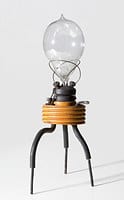Finding meaning in the Thermionic valve
By Nick J Booth, on 26 May 2015
This guest blog has been written by Kelsey Svaren, a placement student who has been working with us over the past few months.
Hi, my name is Kelsey and I am current MA Museum Studies student here at UCL. As part of my program, I am required to undergo a placement where I work on a museum related project. I have spent the last month working closely with Nick Booth, curator of the Electrical Engineering Collections at UCL. I have spent this time researching the numerous thermionic valves in the collection.
Before I started my placement, I had a vague idea of what a thermionic valve is. I knew that it could be used in technologies, such as radios and telephones, to receive and amplify radio signals. Other than that, I was pretty clueless. Since I have started my placement, I have learned more about thermionic valves than I ever thought I would!
The thermionic valve is especially important to UCL, because it’s inventor, John Ambrose Fleming was a professor at UCL and helped to develop the Electrical Engineering Department that we see today.
As science and technology are not my strongest subjects, I am slowly beginning to understand the technology behind these valves. Fleming’s inspiration for the thermionic valve came from something called the Edison Effect. Basically, the Edison Effect occurs when electrons from the metal filament inside of a light bulb are expelled. They adhere to the closest surface, which so happens to be the inside surface of the light bulb. So if you ever see an old light bulb with an uneven metallic coating, you are probably seeing the Edison Effect!
What Fleming did was to harness these electrons, so that he could use them to create a signal detector. He began this experimentation in 1889, but it wasn’t until 1904 that he found success, and invented the very first thermionic valve. All other thermionic valves stem from Fleming’s original scientific research, making his scientific breakthrough one of the most culturally significant inventions of all time.
Within the Electrical Engineering collections, there are several valves that are thought to be Fleming’s experiments. Unfortunately, there has not been much research conducted on these valves. For me, this is one of the most exciting and challenging aspects of the placement process. A lot of the other valves have been manufactured by companies like Marconi, RCA, and EdiSwan. It is relatively easy to look them up online and find the information you need, but the Fleming valve’s pose more of a challenge. Luckily for us, Fleming kept notes of his experiments and they are currently located within UCL Special Collections. I am very excited to start diving into these documents and begin to make sense of the collection of Fleming valves.
Each one of these valves is a small part of a larger story that details the successes, failures, and evolution of Fleming’s experiments until he created the first thermionic valve in 1904. The research and experimentation that Fleming was involved in laid the technological framework for many modern forms of technology that we enjoy today.
Just as each experimental valve is a chapter in Fleming’s story, this grouping of experimental valves serve as an introduction to the narrative of Thermionic valves as a whole. Gaining access to this information will greatly enrich the current understanding of the experimental Fleming valves within the Electrical Engineering collections, and also allow for a more rounded and comprehensive understanding of the thermionic valves as a whole.
This research has proven to be an exciting step for me as student! I have been given a significant opportunity to be involved with important research that will benefit the Electrical Engineering collections. It has been a challenging and rewarding experience so far, allowing me to refine my skills as researcher, while also giving me the opportunity to learn about the science and history behind an immensely influential, yet often overlooked piece of technology.
Kelsey Svaren is a Museum Studies Masters student based at the Institute of Archaeology.
One Response to “Finding meaning in the Thermionic valve”
- 1
 Close
Close






Very interesting